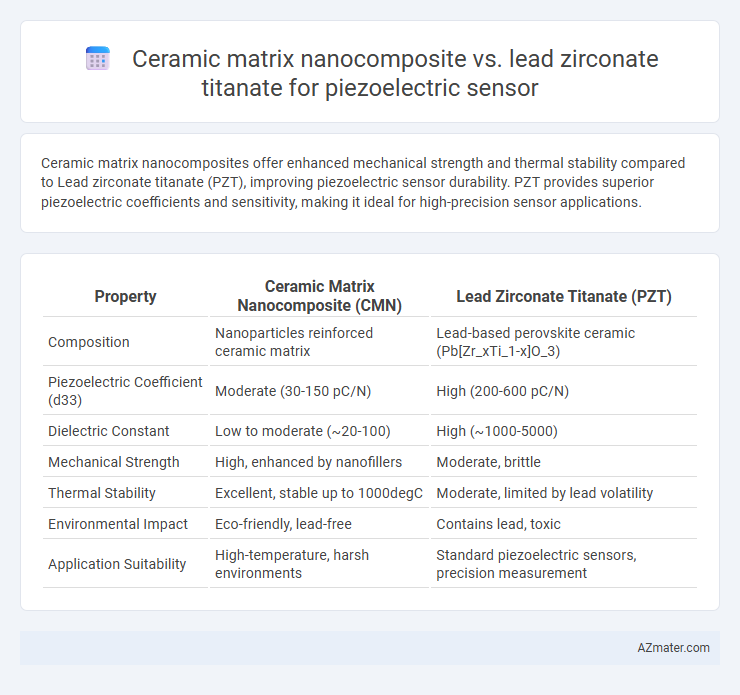Ceramic matrix nanocomposites offer enhanced mechanical strength and thermal stability compared to Lead zirconate titanate (PZT), improving piezoelectric sensor durability. PZT provides superior piezoelectric coefficients and sensitivity, making it ideal for high-precision sensor applications.
Table of Comparison
| Property | Ceramic Matrix Nanocomposite (CMN) | Lead Zirconate Titanate (PZT) |
|---|---|---|
| Composition | Nanoparticles reinforced ceramic matrix | Lead-based perovskite ceramic (Pb[Zr_xTi_1-x]O_3) |
| Piezoelectric Coefficient (d33) | Moderate (30-150 pC/N) | High (200-600 pC/N) |
| Dielectric Constant | Low to moderate (~20-100) | High (~1000-5000) |
| Mechanical Strength | High, enhanced by nanofillers | Moderate, brittle |
| Thermal Stability | Excellent, stable up to 1000degC | Moderate, limited by lead volatility |
| Environmental Impact | Eco-friendly, lead-free | Contains lead, toxic |
| Application Suitability | High-temperature, harsh environments | Standard piezoelectric sensors, precision measurement |
Introduction to Piezoelectric Sensors
Piezoelectric sensors convert mechanical stress into electrical signals through the piezoelectric effect, widely used in medical, automotive, and industrial applications. Ceramic matrix nanocomposites offer enhanced mechanical strength, higher thermal stability, and improved sensitivity compared to traditional piezoelectric materials like Lead zirconate titanate (PZT). Lead zirconate titanate remains a benchmark for piezoelectric sensors due to its high piezoelectric coefficients and established manufacturing processes, yet ceramic matrix nanocomposites present a promising advancement in sensor durability and performance.
Overview of Ceramic Matrix Nanocomposites (CMNCs)
Ceramic matrix nanocomposites (CMNCs) integrate nanoscale reinforcements into ceramic matrices, significantly enhancing mechanical strength, fracture toughness, and thermal stability, which are critical for piezoelectric sensors operating under extreme conditions. These materials offer superior electromechanical coupling and improved dielectric properties compared to traditional ceramics, enabling higher sensitivity and energy conversion efficiency. CMNCs exhibit tailored microstructures that reduce defects and increase durability, outperforming lead zirconate titanate (PZT) in environments requiring long-term reliability and resistance to mechanical fatigue.
Lead Zirconate Titanate (PZT): Properties and Applications
Lead zirconate titanate (PZT) is a widely utilized piezoelectric material known for its high dielectric constant, excellent piezoelectric coefficients, and strong electromechanical coupling, making it ideal for precise sensor applications. Its superior sensitivity and wide temperature stability range enable effective energy conversion in sensors used for medical ultrasound imaging, vibration monitoring, and actuators. Compared to ceramic matrix nanocomposites, PZT offers more consistent performance and higher piezoelectric response, establishing it as the preferred choice for advanced piezoelectric sensor technologies.
Piezoelectric Performance: CMNCs vs. PZT
Ceramic matrix nanocomposites (CMNCs) exhibit enhanced piezoelectric performance compared to lead zirconate titanate (PZT) due to their superior mechanical flexibility, higher fracture toughness, and improved dielectric properties. CMNCs demonstrate increased piezoelectric coefficients (d33) and electromechanical coupling factors, resulting from the nanoscale reinforcement that enhances polarization stability and domain wall mobility. In contrast, PZT offers high piezoelectric sensitivity but suffers from brittleness and lead toxicity, making CMNCs a more durable and environmentally friendly option for advanced piezoelectric sensors.
Mechanical Strength and Durability Comparison
Ceramic matrix nanocomposites typically exhibit superior mechanical strength and enhanced durability due to their nanoscale reinforcements, which improve fracture toughness and resistance to wear compared to Lead Zirconate Titanate (PZT). PZT, while offering excellent piezoelectric properties, tends to be more brittle and prone to mechanical degradation under cyclic loading or harsh environmental conditions. The integration of nanoparticles in ceramic matrices results in improved crack deflection and energy absorption mechanisms, making nanocomposites more reliable for long-term sensor applications where mechanical robustness is critical.
Thermal Stability and Operating Conditions
Ceramic matrix nanocomposites exhibit superior thermal stability compared to lead zirconate titanate (PZT), maintaining piezoelectric properties at temperatures exceeding 400degC, whereas PZT typically operates effectively below 250degC. The enhanced thermal stability of ceramic matrix nanocomposites makes them suitable for high-temperature sensor applications in harsh environments such as aerospace and automotive industries. PZT's lower thermal endurance limits its use to moderate temperature conditions, restricting its application in extreme operating scenarios.
Fabrication Techniques and Scalability
Ceramic matrix nanocomposites (CMNCs) for piezoelectric sensors are typically fabricated using sol-gel processing, spark plasma sintering, or hot pressing, which allow precise control over nanoparticle dispersion and microstructure, enhancing piezoelectric properties. Lead zirconate titanate (PZT) sensors rely on conventional solid-state sintering or tape casting methods, offering well-established, cost-effective large-scale manufacturing with high reproducibility. CMNC fabrication faces scalability challenges due to complex processing parameters and nanoparticle uniformity requirements, whereas PZT benefits from mature industrial processes enabling high-volume production for commercial piezoelectric sensor applications.
Environmental Impact and Biocompatibility
Ceramic matrix nanocomposites exhibit superior environmental sustainability compared to lead zirconate titanate (PZT) due to their lead-free composition, significantly reducing toxic waste and heavy metal contamination risks. Their biocompatibility is enhanced by the absence of lead, making them more suitable for medical and wearable piezoelectric sensors exposed to human tissue. In contrast, PZT's lead content poses environmental challenges and potential cytotoxicity, limiting its application in eco-friendly and biocompatible sensor technologies.
Application Suitability: CMNCs vs. PZT in Sensing
Ceramic matrix nanocomposites (CMNCs) exhibit enhanced mechanical flexibility and thermal stability compared to lead zirconate titanate (PZT), making them more suitable for high-temperature and flexible piezoelectric sensor applications. While PZT offers superior piezoelectric coefficients and energy conversion efficiency, its brittleness and lead content limit environmental compatibility and adaptability in wearable or biocompatible devices. CMNCs combine improved durability and non-toxic composition, enabling broader application ranges in harsh environments and emerging flexible electronics where traditional PZT sensors may underperform.
Future Trends and Developments in Piezoelectric Materials
Ceramic matrix nanocomposites demonstrate enhanced mechanical flexibility and improved thermal stability, positioning them as a promising alternative to traditional lead zirconate titanate (PZT) in next-generation piezoelectric sensors. Research increasingly focuses on integrating nanostructured reinforcements to boost piezoelectric coefficients and durability while addressing environmental concerns associated with lead-based materials. Future developments aim to optimize synthesis methods and nano-scale engineering to achieve higher sensitivity, multifunctionality, and biocompatibility in piezoelectric devices.

Infographic: Ceramic matrix nanocomposite vs Lead zirconate titanate for Piezoelectric sensor
 azmater.com
azmater.com